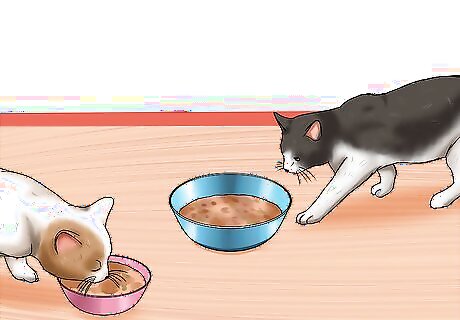
views
Using Water to Separate Fighting Cats

Fill up a plastic spray bottle with water. A standard sized spray bottle (16 fluid ounces) works fine. Ensure the water and the bottle are clean. Do not use bottles that had bleach or other chemicals in them.

Aim the plastic nozzle at the cats. You can aim the bottle at one or both cats. If your cat is familiar with the spray bottle and what it does, the very sight of it is likely to send it running and end the conflict.

Pull the plastic handle. With the spray bottle's nozzle leveled at the cats, open fire. Spray two to three times rapidly from a safe distance away. The cats will likely saunter off to groom themselves. If your cats continue fighting, squirt another two to three times. Continue as many times as necessary to end the fighting. Do not get too close or attempt to manually separate two fighting cats. You will get scratched or bitten.

Use a garden hose on the fighting cats. If you're outside and the weather is warm, you could turn the garden hose on your cats. If your hose has a nozzle and handle on it, use it in the same way you would the water bottle inside. Aim the nozzle at the cats from a distance of three or four meters, squeeze the handle a few times, and enjoy the peace and quiet again. Collect your cat and bring it inside. If your hose doesn't have a spray nozzle on it, place your thumb partially over the hole where the water comes out. This builds up a bit of pressure behind the hole and will cause the water that does come out to travel a greater distance. Use this technique to spray water on the fighting cats just as you would if you had a spray handle on your hose.

Squirt your cats with a squirt gun. As an alternative to using a hose, you could also use a squirt gun for cats that are fighting outside. Fill the squirt gun with water, aim it at the fighting cats, and fire a three to four second stream at the cats. If they do not stop fighting, spray another three to four second burst. Continue until the conflict ends. Do not use water to break up a cat fight outside during winter. Cats can easily develop hypothermia and die. You could substitute a small, less powerful squirt gun for a spray bottle, as well.
Making Loud Sounds to Stop Two Cats From Fighting

Yell loudly. You could say things like “Hey! What are you doing?” in a loud, irritated way. You should also clap your hands together rapidly several times. Alternately, if you have a kerchief handy, wave it around your head to gain the attention of the fighting cats while you tell at them. All of these things will distract them from each other and end the fight.

Bang pans together. Get two sturdy pans and knock them together several times in the general area where your cats are fighting. They will both likely be startled by the sound and scamper off in different directions. If you have only one pan handy, strike it with a metal object like a large metal ladle or pair of tongs repeatedly to achieve the same effect.

Shake a can of pennies. If you have a tin can with a resealable lid, you can fill it with pennies to distract the fighting cats from each other and end their fight. Small coffee tins are great for this, as are cans of sriracha peas and small tins of cookies or toffee. Fill the can with a handful of pennies, dimes, or other small coins and give it a few vigorous shakes for about five seconds from a distance of three to four meters.

Sound an air horn. An air horn is a hand-held can of pressurized air that passes through a horn, creating a loud sound. Point the horn away from you and press the button on top of the can. Hold it for just a second or two. Your cats will run off when they hear the sound. Air horns can be extremely loud, so use it from at least three to four meters away from the fighting cats.
Use a portable vacuum cleaner. If the cats are near your house and you have a charged portable vacuum cleaner, you can grab that and turn it on near the cats. Many animals including cats and dogs dislike the loud noise that vacuum cleaners make. This will be sure to break up the cat fight in no time, as the cats will immediately run off, even if they already had their claws dug into each other.
Throwing Things to Distract the Cats

Throw a blanket over the cats. The sudden disorientation the accompanies being covered by a blanket will get the cats to stop fighting and focus on escaping from under the blanket. You could also use a large jacket or a towel to achieve the same effect.

Toss small, soft pillows near the cats. You can include a few exclamatory remarks like, “Hey! Break it up!” along with your pillow-throwing for added effect. With a barrage of pillows raining down on them, both cats will be eager to exit the area. You should aim for the area around them, but if they don't heed your presence right away, don't hesitate to throw pillows at them with moderate force. Take care not to hit either cat in the face.

Throw a toy near the cats. If one cat sees its favorite toy, it may be inclined to leave the conflict and instead play with the toy. If you suspect the other cat will pursue the cat that left the fight, give both cats their favorite toys. You could also try tossing two cat treats in opposite directions. Rustle the bag and make a big show of removing the treats for your cats. This will ensure they see the treats being tossed.
Preventing Cat Fights

Look for signs of aggression. Before the fight starts, you'll typically see your cat and/or another cat hissing menacingly, each with its hair bristling along its back and its ears pinned down. At this point, move to take your cat out of the situation before a tussle begins. If the cats seem determined to fight, confine one or both cats to separate rooms.

Discover why your cat is fighting. Has one cat recently reached sexual maturity? Is your cat in a new home where it needs to establish its territory and tussle with other cats to do so? Think about recent changes in your cat's lifestyle or biology to figure out why it might be fighting. Once you've figured out why cats are fighting, you can take steps to prevent it. For instance, if a cat has recently reached sexual maturity, it's probably experiencing a tidal wave of hormonal changes. Spaying and neutering your cats can reduce or eliminate this cause of cat fights.

Keep your cat indoors. The cat that stays inside is the cat that never engages in a cat fight with other cats (unless the other cat also lives in your home). Keep your windows and doors closed. Stay mindful when opening the door. If necessary, have a family member close the cat in a certain room before you or another family member leaves the house. Then, let the cat out to resume its normal activities around the house. This will ensure your cat never gets the chance to escape outside and fight another cat. If your cat fight is between two of your cats, confine them to separate rooms until they've calmed down.

Pay equal attention to all your cats. Cats, like people, can become jealous of each other. If you're fawning over a new cat or kitten, your existing cat might resent that. Certain breeds (such as Siamese) are more susceptible to jealousy than others. Spend time praising and playing with all your cats to lay their fears of being replaced to rest.

Create positive associations between two cats that don't get along. When two cats make a habit out of conflict, you need to break this negative behavior pattern by replacing it with a positive one. When the two cats are present in the same room, give each some tasty treats. Feed them their treats at the same time out of separate bowls placed reasonably far apart so that they don't feel threatened. Be sure to give each the same amount of treats and attention, or they will only become more jealous of one another.

Give each cat its own space. Multiple cats in one household should not eat out of a single common food bowl. Provide each cat with its own food and water bowls, and provide adequate space between each bowl. Similarly, provide multiple cat scratch posts, cat houses/perches, and litter boxes if you have multiple cats. The general rule is that however many cats you own, you should have that many litterboxes, plus one. For example, if you have two cats, you should have three litter boxes.

Do not invest in a grown cat of the same gender as the one you already have. If your adult cat has lived on its own for all or most of its life, it is used to being the dominant cat of the house. Introducing a kitten -- especially a kitten of the opposite gender as your current cat -- will minimize the possibility that the cats will engage in conflict. Cats of the same gender will see the other as competition for potential mates, and their likelihood of conflict will increase. You could decrease conflict among cats of the same gender by spaying or neutering your cats.




















Comments
0 comment